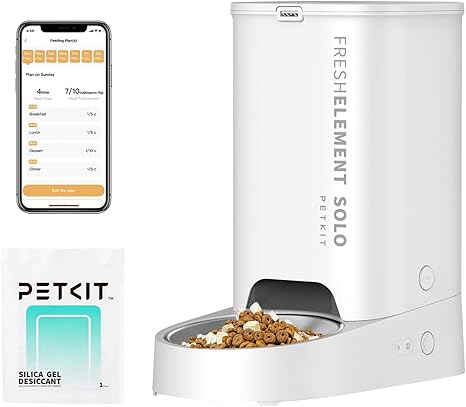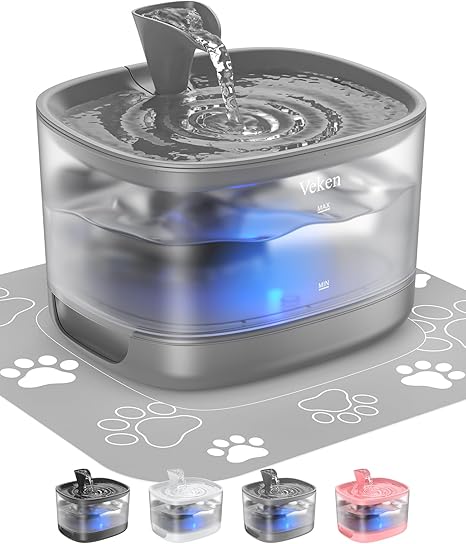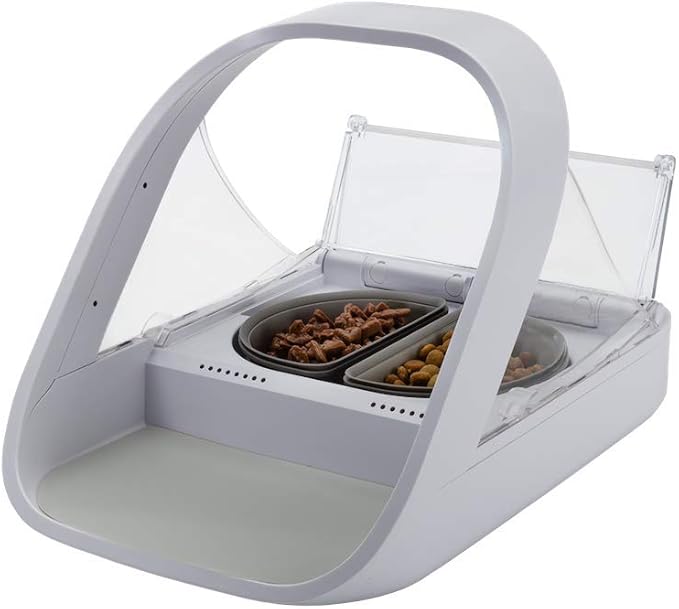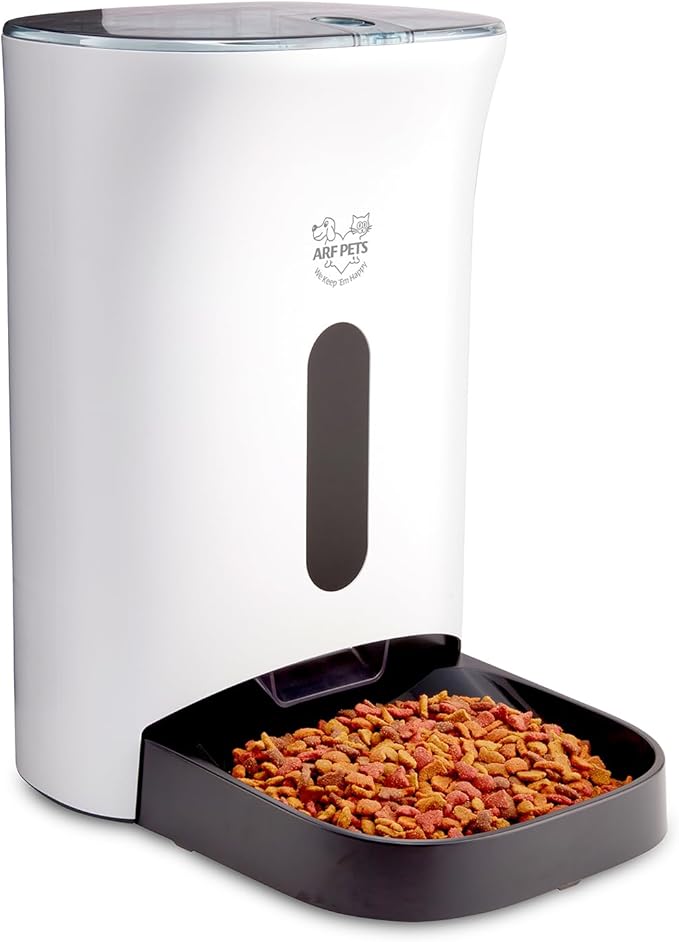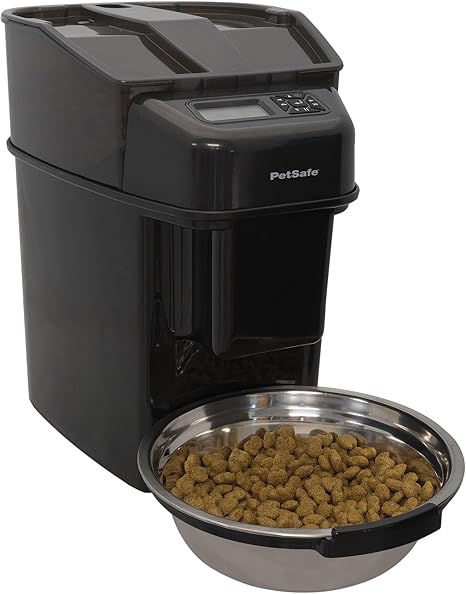Automatic feeders paired with circulating water fountains are the most reliable way to keep your cat on schedule with fresh hydration every single day. Keeping your cat properly fed and hydrated is essential for their health and wellbeing. With busy schedules and varying routines, automatic feeders and water fountains have become indispensable tools for modern cat owners. This comprehensive guide explores the best automatic feeding and hydration solutions for cats, helping you choose the perfect system for your feline friend's needs.
Why Do Automatic Feeders and Water Fountains Matter for Your Cat's Health?
Quick Answer: Automatic feeders and water fountains provide consistent nutrition, prevent overeating, and encourage proper hydration, reducing health risks and giving you peace of mind.
Cats are creatures of habit who thrive on routine. Consistent feeding schedules and access to fresh water are crucial for their physical and mental health. The American Veterinary Medical Association stresses that portion control and predictable meal timing reduce obesity and metabolic risks. Automatic feeders and water fountains provide several key benefits that make them essential for responsible cat ownership. For comprehensive cat care essentials, these automated systems are game-changers.
What Are the Key Benefits of Automatic Cat Feeders?
Automatic cat feeders offer numerous advantages for both cats and their owners. They ensure consistent feeding schedules, even when you're away from home, which is particularly important for cats with medical conditions that require regular medication or specific feeding times.
- Consistent Schedule: Maintains regular feeding times that cats naturally prefer
- Portion Control: Prevents overfeeding and helps manage weight - essential for smart feeder wellness plans
- Convenience: Allows for overnight stays or extended time away from home
- Multiple Cat Management: Some models can feed different cats different amounts
- Medication Integration: Can be programmed to dispense medication with food, working perfectly with AI-assisted feeding systems
How Do Water Fountains Improve Your Cat's Hydration?
Water fountains encourage cats to drink more water, which is essential for preventing urinary tract issues, kidney problems, and maintaining overall health. The ASPCA notes that many cats are naturally reluctant drinkers, so moving water helps meet their daily hydration targets. The flowing water mimics natural water sources and is more appealing to cats than stagnant water in bowls.
- Increased Hydration: Flowing water encourages more frequent drinking
- Fresh Water: Continuous circulation keeps water oxygenated and fresh
- Filtration: Built-in filters remove impurities and improve taste
- Health Benefits: Reduces risk of urinary tract infections and kidney disease - crucial for ongoing pet health monitoring
- Appeal: Moving water is more attractive to cats than still water
What Types of Automatic Cat Feeders Are Available in 2025?
Quick Answer: There are three main types: Smart WiFi feeders for remote control, timer-based feeders for reliability, and gravity feeders for simplicity and continuous access.
Understanding the different types of automatic feeders available will help you choose the best option for your cat's specific needs and your lifestyle requirements.
Smart WiFi Feeders
Smart WiFi feeders represent the latest in pet feeding technology, offering remote control, scheduling, and monitoring capabilities through smartphone apps. These advanced systems provide unprecedented control and peace of mind for cat owners.
Key features include real-time notifications when your cat eats, portion size adjustments, feeding history tracking, and the ability to dispense treats remotely. Some models even include cameras so you can watch your cat during feeding times.
Timer-Based Feeders
Timer-based feeders are reliable, straightforward solutions that dispense food at preset times. These feeders are perfect for maintaining consistent feeding schedules without the complexity of smart technology.
Most timer feeders can be programmed for multiple daily feedings, with some offering up to 12 different meal times. They're typically battery-powered with backup power options to ensure your cat never misses a meal.
Gravity Feeders
Gravity feeders provide continuous access to food through a simple mechanism that refills the bowl as your cat eats. While not technically "automatic" in terms of scheduling, they ensure your cat always has food available.
These feeders are ideal for cats who self-regulate their food intake well and don't tend to overeat. They're also excellent backup options for when you're away for extended periods.
Types of Water Fountains for Cats
Water fountains come in various designs and sizes, each offering different benefits for your cat's hydration needs and your home's aesthetic preferences.
Ceramic Fountains
Ceramic water fountains are popular for their durability, ease of cleaning, and natural appearance. The ceramic material helps keep water cool and doesn't retain odors or bacteria as easily as plastic alternatives. For more on eco-friendly cat products, ceramic fountains are excellent choices.
These fountains are typically dishwasher-safe and come in various colors and designs to complement your home decor. They're also less likely to be knocked over by active cats.
Plastic Fountains
Plastic water fountains are often more affordable and lightweight than ceramic options. Many feature multiple water streams and attractive designs that appeal to cats while being easy to maintain.
Look for BPA-free plastic fountains with replaceable filters and easy disassembly for thorough cleaning. Some models include LED lights for added visual appeal.
Stainless Steel Fountains
Stainless steel fountains offer excellent durability and hygiene benefits. The non-porous surface prevents bacterial growth and is easy to clean and maintain.
These fountains are particularly good for cats with sensitive skin or allergies, as stainless steel doesn't harbor bacteria or cause allergic reactions like some plastics might.
Automatic Cat Feeder Comparison Guide
| Feature | Smart WiFi Feeders | Timer Feeders | Gravity Feeders |
|---|---|---|---|
| Remote Control | Yes — Smartphone app | No — Manual setup only | No — No control |
| Feeding Schedule | Multiple daily meals | Programmed times | Continuous access |
| Portion Control | Yes — Precise portions | Yes — Adjustable portions | No — Self-regulated |
| Power Requirements | AC + WiFi | Battery backup | No power needed |
| Price Range | $100-$300+ | $30-$100 | $20-$60 |
| Best For | Tech-savvy owners | Reliable scheduling | Simple solutions |
Expert Recommendation
Choose smart WiFi feeders for maximum control and monitoring, timer feeders for reliable scheduling, or gravity feeders for simplicity and continuous access.
Key Features to Consider
When choosing automatic feeders and water fountains, several key features will determine how well they meet your cat's needs and fit into your lifestyle.
Capacity and Size
Consider your cat's daily food consumption and how often you want to refill the feeder. Larger capacity feeders are ideal for extended absences, while smaller models work well for daily use with regular refilling. Understanding your cat's nutritional needs will help you choose the right capacity.
For water fountains, larger reservoirs mean less frequent refilling and more consistent water availability. However, ensure the fountain size is appropriate for your cat's size and drinking preferences.
Power Options
Most automatic feeders and water fountains require power to operate. Look for models with battery backup options to ensure continued operation during power outages.
Some advanced models include solar charging capabilities or can operate for extended periods on battery power alone, providing peace of mind during emergencies.
Ease of Cleaning
Regular cleaning is essential for maintaining your cat's health and the longevity of your feeding and watering equipment. Choose models that are easy to disassemble and clean thoroughly.
Look for dishwasher-safe components, removable parts, and clear cleaning instructions. Some models include cleaning reminders or indicators to help you maintain proper hygiene.
Complete Buyer's Guide: How to Choose the Perfect Cat Feeder and Water Fountain
Step 1: Assess Your Needs
- • How many cats do you have?
- • What's your daily routine like?
- • Do you travel frequently?
- • What's your budget range?
- • Do you prefer smart technology?
Step 2: Research Features
- • Compare capacity and portion control
- • Check power requirements and backup
- • Review cleaning and maintenance needs
- • Read customer reviews and ratings
- • Consider warranty and support
Step 3: Budget Planning
- • Basic models: $30-60
- • Mid-range options: $60-150
- • Premium systems: $150-300+
- • Factor in ongoing costs (filters, batteries)
- • Consider long-term value
Step 4: Setup & Maintenance
- • Choose optimal placement location
- • Plan gradual introduction to your cat
- • Schedule regular cleaning routines
- • Monitor your cat's adaptation
- • Keep backup feeding options ready
Pro Tips for Success
For First-Time Users:
Start with a simple timer-based feeder to get comfortable with the concept before upgrading to smart features.
For Tech Enthusiasts:
Smart WiFi feeders offer the most features but require stable internet and smartphone compatibility.
For Budget-Conscious:
Gravity feeders provide basic automation at the lowest cost, perfect for cats who self-regulate well.
For Multi-Cat Homes:
Consider individual feeders or models with microchip recognition for personalized feeding.
Installation and Setup Tips
Proper installation and setup are crucial for the success of your automatic feeding and watering system. Following these guidelines will ensure optimal performance and your cat's comfort.
Placement Considerations
Place feeders and water fountains in quiet, low-traffic areas where your cat feels comfortable eating and drinking. Avoid locations near litter boxes, noisy appliances, or areas with heavy foot traffic.
Ensure the location has easy access to power outlets and is convenient for you to refill and maintain. Consider placing multiple water sources throughout your home to encourage hydration.
Gradual Introduction
Introduce new feeders and fountains gradually to help your cat adjust. Start by placing them near existing feeding areas and gradually move them to their final locations.
Allow your cat to explore the new equipment at their own pace. Some cats may be hesitant initially, but most will adapt quickly to the convenience and consistency of automatic systems.
Maintenance and Care
Regular maintenance ensures your automatic feeders and water fountains continue to work effectively and provide clean, safe food and water for your cat.
Daily Maintenance
Check food and water levels daily, even with automatic systems. Monitor your cat's eating and drinking patterns to ensure the equipment is working properly and your cat is consuming adequate amounts.
Clean food bowls and water surfaces daily to prevent bacterial growth and maintain freshness. Remove any uneaten food promptly to prevent spoilage.
Weekly Maintenance
Perform thorough cleaning of all components weekly. Disassemble feeders and fountains completely, wash all parts with mild soap and water, and replace filters as recommended by the manufacturer.
Check for any signs of wear or malfunction during weekly maintenance. Address any issues promptly to prevent problems that could affect your cat's health or the equipment's performance.
Troubleshooting Common Issues
Understanding common issues and their solutions will help you maintain optimal performance of your automatic feeding and watering systems.
Feeder Not Dispensing Food
If your automatic feeder stops dispensing food, check the power connection, battery levels, and programming settings. Ensure the food hopper isn't empty and that food isn't stuck in the dispensing mechanism.
Clean the dispensing mechanism regularly to prevent food from becoming stuck or clogged. Some feeders may require specific types of food to function properly.
Water Fountain Not Working
Water fountain issues often relate to pump problems, clogged filters, or insufficient water levels. Check that the pump is properly seated and that filters are clean and properly installed.
Ensure the water level is adequate for the pump to function and that the fountain is placed on a level surface. Regular filter replacement is essential for optimal performance.
Health and Safety Considerations
While automatic feeders and water fountains provide convenience, it's important to consider health and safety aspects to ensure your cat's wellbeing.
Food Safety
Store dry food properly to maintain freshness and prevent contamination. Use airtight containers and avoid storing food in the feeder's hopper for extended periods without cleaning.
Monitor food for signs of spoilage, especially in humid environments. Some automatic feeders include features to help maintain food freshness, such as airtight seals or humidity control.
Water Quality
Maintain clean, fresh water in fountains by following manufacturer cleaning recommendations. Replace filters regularly and monitor water quality, especially if your cat has health conditions that require special attention to hydration.
Consider your local water quality when choosing fountain filters. Some areas may require additional filtration to provide optimal water quality for your cat.
Cost Considerations and Budget Planning
Automatic feeders and water fountains range from basic models to advanced smart systems. Understanding the cost factors will help you make informed decisions that fit your budget and needs.
Initial Investment
Basic automatic feeders start around $30-50, while smart WiFi models can cost $100-300 or more. Water fountains range from $20-100 depending on features and materials.
Consider the long-term value of your investment. Higher-quality models may cost more initially but often provide better reliability, durability, and features that justify the higher price.
Ongoing Costs
Factor in ongoing costs such as replacement filters, batteries, and maintenance supplies. Smart feeders may require app subscriptions for advanced features.
Calculate the total cost of ownership over the expected lifespan of the equipment. Sometimes, spending more upfront on a quality product can save money in the long run.
Future Trends in Pet Feeding Technology
The pet feeding industry continues to evolve with new technologies and innovations that promise to make pet care even more convenient and effective.
AI-Powered Feeding
Future feeders may incorporate artificial intelligence to learn your cat's eating patterns and adjust feeding schedules automatically. These systems could detect changes in appetite that might indicate health issues.
AI-powered systems might also provide personalized nutrition recommendations based on your cat's age, weight, activity level, and health status, creating truly customized feeding programs.
Health Monitoring Integration
Advanced feeders may integrate with health monitoring devices to track your cat's weight, eating patterns, and overall health. This data could be shared with veterinarians for better health management.
Some systems may include built-in scales, cameras, or sensors that monitor your cat's condition and alert you to potential health concerns before they become serious problems.
Frequently Asked Questions About Automatic Cat Feeders and Water Fountains
How often should I clean my cat's automatic feeder?
Answer: Clean your automatic feeder weekly with mild soap and water, and perform a deep cleaning monthly.
Regular cleaning prevents bacterial growth and ensures your cat's food stays fresh. Disassemble all parts according to manufacturer instructions and let them air dry completely before reassembling.
Do water fountains really encourage cats to drink more water?
Answer: Yes, studies show that cats drink up to 50% more water when using fountains compared to still water bowls.
The flowing water mimics natural water sources and is more appealing to cats. This increased hydration helps prevent urinary tract infections and kidney disease, especially important for older cats.
What's the difference between smart WiFi feeders and regular timer feeders?
Answer: Smart WiFi feeders offer remote control, feeding notifications, and detailed analytics, while timer feeders provide simple, reliable scheduled feeding.
WiFi feeders are ideal for tech-savvy owners who want monitoring capabilities and remote feeding options. Timer feeders are perfect for those who prefer simplicity and reliability without internet dependency.
How much should I spend on an automatic cat feeder?
Answer: Budget $30-100 for basic feeders, $100-200 for smart WiFi models, and $200+ for premium systems with advanced features.
Consider your cat's needs, your lifestyle, and long-term value. Higher-priced models often offer better reliability, more features, and longer warranties that justify the investment.
Can automatic feeders work with wet food?
Answer: Some advanced models can dispense wet food, but most automatic feeders are designed for dry kibble due to spoilage concerns.
If you need to feed wet food automatically, look for models with refrigeration capabilities or consider hybrid systems that combine dry and wet food dispensing with proper cooling.
How do I introduce my cat to an automatic feeder?
Answer: Place the feeder near your cat's current feeding area and gradually move it to the desired location over 3-5 days.
Start with manual dispensing to let your cat get comfortable with the feeder's presence and sounds. Once they're eating normally, gradually introduce the automatic features.
What size water fountain is best for my cat?
Answer: Choose a fountain with at least 2-3 liters capacity for single cats, and larger models (3-5 liters) for multiple cats or less frequent refilling.
Consider your cat's size, drinking habits, and how often you want to refill. Larger fountains provide more water circulation and require less frequent maintenance.
Are automatic feeders safe for kittens?
Answer: Yes, but choose models with smaller portion sizes and ensure the feeder is stable and kitten-proof.
Kittens need more frequent, smaller meals. Look for feeders with adjustable portion sizes and secure designs that won't tip over. Always supervise initial use.
Which automatic feeder works best for multiple cats in 2025?
Answer: Microchip-controlled feeders like the SureFeed Connect assign meals to the right cat automatically.
These units read each cat's microchip or RFID collar tag, unlock only for the matching pet, and let you log calorie intake per cat—perfect for preventing food stealing and managing special diets.
How often should I replace filters in a cat water fountain?
Answer: Replace filters every two to four weeks, or sooner if you notice buildup or odor.
Homes with hard water or multiple cats may need weekly changes. Mark your calendar and keep spare filters on hand so your fountain always circulates clean, great-tasting water.
Conclusion
Automatic feeders and water fountains for cats represent essential tools for modern pet ownership, providing convenience, consistency, and health benefits for both cats and their owners. By understanding the different types available, key features to consider, and proper maintenance requirements, you can choose the perfect system for your cat's needs. These systems work perfectly with other cat enrichment activities and indoor exercise solutions.
Whether you opt for a simple timer-based feeder or an advanced smart system with WiFi connectivity, the right automatic feeding and watering solution will help ensure your cat receives proper nutrition and hydration consistently. Remember to consider your cat's specific needs, your lifestyle, and your budget when making your selection. For additional guidance on senior and kitten cat care, these automated systems are particularly beneficial.
With proper setup, maintenance, and care, automatic feeders and water fountains will provide years of reliable service while contributing to your cat's health and happiness. The investment in quality equipment pays dividends in peace of mind and your cat's wellbeing. Explore our comprehensive pet wellness product hub and budget-friendly emergency prep picks to ensure you're fully prepared for your cat's health journey.

